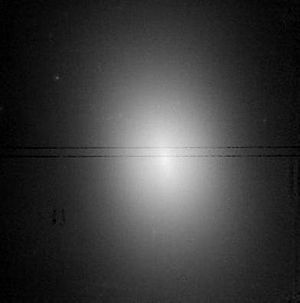NGC 1600
aus Wikipedia, der freien Enzyklopädie
| Galaxie Daten von NGC 1600 | |
|---|---|

| |
| Aufnahme des Hubble-Weltraumteleskops | |
| AladinLite | |
| Sternbild | Eridanus |
| Position Äquinoktium: J2000.0, Epoche: J2000.0 | |
| Rektaszension | 04h 31m 39,9s[1] |
| Deklination | −05° 05′ 10″[1] |
| Erscheinungsbild | |
| Morphologischer Typ | E3[1] |
| Helligkeit (visuell) | 11,0 mag[2] |
| Helligkeit (B-Band) | 12,0 mag[2] |
| Winkelausdehnung | 2,5′ × 1,7′[2] |
| Positionswinkel | 15°[2] |
| Flächenhelligkeit | 12,6 mag/arcmin²[2] |
| Physikalische Daten | |
| Zugehörigkeit | LDCE 312[1] |
| Rotverschiebung | 0.015614 ± 0.000027[1] |
| Radialgeschwindigkeit | (4681 ± 8) km/s[1] |
| Hubbledistanz H0 = 73 km/(s • Mpc) |
(205 ± 14) · 106 Lj (63,0 ± 4,4) Mpc [1] |
| Durchmesser | 150.000 Lj[3] |
| Geschichte | |
| Entdeckung | William Herschel |
| Entdeckungsdatum | 26. November 1786 |
| Katalogbezeichnungen | |
| NGC 1600 • PGC 15406 • MCG -01-12-17 • 2MASX J04313985-0505099 • GC 866 • H I 158 • h 319 • | |
NGC 1600 ist eine elliptische Galaxie vom Hubble-Typ E3 im Sternbild Eridanus am Südsternhimmel, die schätzungsweise 205 Millionen Lichtjahre von der Milchstraße entfernt ist. Die Galaxie eine scheinbare Helligkeit von 11,0 mag und ist als starke Quelle von Röntgenstrahlung bekannt.
Das Objekt wurde am 26. November 1786 von Wilhelm Herschel entdeckt.[4]
Obwohl NGC 1600 oft als ein Mitglied einer losen Gruppe von Galaxien klassifiziert wird, nehmen Wissenschaftler an, es könnte sich dabei um Satellitengalaxien von NGC 1600 handeln, da alle benachbarten Galaxien viel lichtschwächer sind und die Anzahl mit der Entfernung zu NGC 1600 abnimmt. Zu den etwa 30 bekannten Galaxien, die sich in einer Entfernung von bis zu 1 MPc befinden und eine ähnliche Rotverschiebung besitzen, gehören unter anderem NGC 1601, NGC 1603, NGC 1604, NGC 1606, NGC 1580, NGC 1594, NGC 1599, NGC 1607, NGC 1611 und IC 373.[5]
Das Zentrum der relativ isolierten Galaxie enthält ein Schwarzes Loch mit einer Masse 17 Milliarden Mal größer als die unserer Sonne.[6] Dies ist eines der größten Schwarzen Löcher, das bis heute gefunden wurde. Zum Vergleich: Das zentrale schwarze Loch der Milchstraße hat rund 4 Millionen Sonnenmassen. Zusätzlich ist das Zentrum der Galaxie sehr arm an Sternen, was darauf hinweisen könnte, dass hier einst zwei Galaxien – und ihre Schwarzen Löcher – verschmolzen[7] und dabei viele Sterne aus dem Zentrum herausgeschleudert wurden.
Weblinks
[Bearbeiten | Quelltext bearbeiten]- astronews.com: Riesiges Schwarzes Loch in isolierter Galaxie 8. April 2016
- CDS Portal
Einzelnachweise
[Bearbeiten | Quelltext bearbeiten]- ↑ a b c d e NASA/IPAC EXTRAGALACTIC DATABASE
- ↑ a b c d e SEDS: NGC 1600
- ↑ NASA/IPAC
- ↑ Seligman
- ↑ Rodney M. Smith, Vicent J. Martínez, Alberto Fernández‐Soto, Fernando J. Ballesteros, Amelia Ortiz‐Gil: NGC 1600: Cluster or Field Elliptical?. In: The Astrophysical Journal. 679, 2008, S. 420, doi:10.1086/587454.
- ↑ heise.de: Astronomen finden supermassives Schwarzes Loch an unerwartetem Ort, abgerufen am 7. April 2016
- ↑ M. Matthias, O. Gerhard: Dynamics of the boxy elliptical galaxy NGC 1600. In: Monthly Notices of the Royal Astronomical Society. 310, 1999, S. 879, doi:10.1046/j.1365-8711.1999.03022.x.
Text is available under the CC BY-SA 4.0 license; additional terms may apply.
Images, videos and audio are available under their respective licenses.
